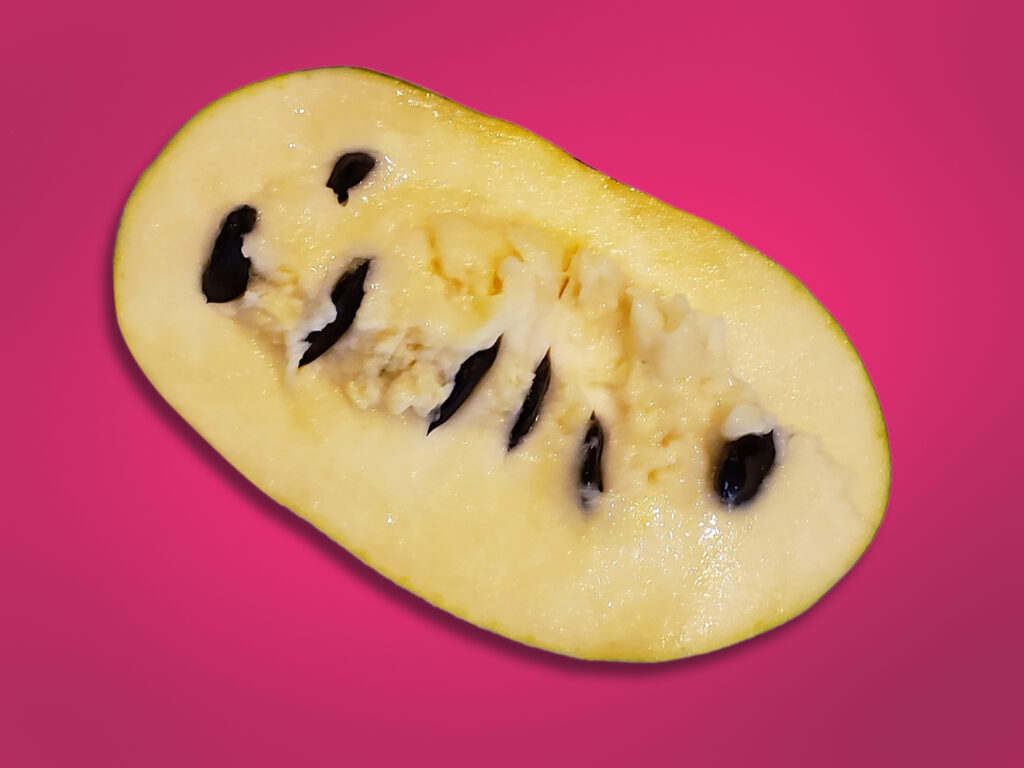A Go-To Guide for Tracking Down Trees, Fruit, and Seeds
This post contains affiliate links. As a member of Amazon Associates, I may earn a commission from qualifying purchases at no cost to you.
A search for “pawpaws” can generate endless results that are off the mark – such as papayas or “World’s Greatest Pawpaw” t-shirts because Grandparents Day is around the corner.
So how do you wade through a mountain of information and avoid a wild goose chase? Whether you’re a new grower or aspiring chef, this guide will point you in the right direction to find the North American pawpaw (Asimina triloba).
Pawpaw Trees
In most cases, the answer to finding pawpaw trees is in the palm of your hand – on your smart phone.
A great option to track down pawpaws is iNaturalist, a joint initiative by the California Academy of Sciences and the National Geographic Society. The free app is safe and secure and allows users to geolocate plants and animals thanks to crowdsourcing of data from contributors around the country.
As a friendly reminder, foraging is prohibited at certain park districts and botanical gardens. Always request permission to visit private property from the owners.
Superior pawpaws have been developed and trademarked by West Virginia pawpaw breeder Neal Peterson (Shenandoah, Susquehanna, Rappahannock, Allegheny, Potomac, Wabash, and Tallahatchie). His website lists licensed nurseries that carry his cultivars in the United States, Canada, and Europe.
Kentucky State University has the only full-time pawpaw research program, in the world and is home to the USDA National Clonal Germplasm Repository for Pawpaws. The department’s website has a directory of licensed nurseries that offer its cultivars (KSU-Atwood, KSU-Benson, and KSU-Chappell).
A word of caution: beware of certain sellers on social media platforms and ask yourself, “Does this business have a nursery and/or vendor license?” Legitimate retailers care about plant health and have clear terms of service, transaction records, and return policies.
Pawpaw Fruit
Fresh pawpaws have a notoriously short shelf-life and can easily bruise.
Although shipping is a challenge – and can be costly – there are online ordering options if fruit is not readily available in your area.
Foraged Market has created a new “forest-to-table” community by providing access to wild and specialty foods. The company sponsored the Pawpaw Cookoff at the Ohio Pawpaw Festival and launch of The Joy of Pawpaw cookbook.
This year, pawpaws from Earthy Delights were featured on the Today show. The Michigan-based company offers fresh fruit, frozen pulp, and a selection of other products.
Several of the licensed nurseries for Peterson and KSU cultivars manage pawpaw orchards. Also, check with your local greenhouse or farmers market for possible leads.
Outside of conventional channels, buyer protection may not be top-of-mind with the thrill of finding a food treasure in short supply. Cottage food production operation laws vary by state. Take the time to make sure the vendor is following safe food guidelines for fresh produce or value-added products.
Pawpaw Seeds
Why grow from seed? There are several reasons, including: introducing genetic diversity for cross-pollination; growing hardy rootstock for grafting; and establishing native, edible landscaping.
If you’re ready to get started now, visit our shop for Pawpaw Seed Kits. Our stratified seeds are packaged in moist sphagnum peat moss with germinating instructions to help ensure success. The seeds have been inspected by the Ohio Department of Agriculture, and all purchases are covered by our one-year limited guarantee.
Depending on availability, Kentucky State University offers free seeds upon written request. From the program’s website:
“Seed obtained from high quality fruit may also produce trees with good fruit, but quality will vary considerably from seedling to seedling. If you’re not sure pawpaws will grow in your area, try planting a large number of seeds from a climate zone similar to yours, and you can select the seedlings that do well in your location. Trees that produce disappointing fruit can be grafted later with a superior variety.”
You can contact the KSU Pawpaw Program Personnel and read the Pawpaw Planting Guide for more information.
Book Smarts
What are your next steps while hunting for pawpaw trees, fruit, or seeds? Fortunately, there are many solid resources available to support you on this venture.
Pawpaw: In Search of America’s Forgotten Fruit (2017) by Andrew Moore, a Pittsburgh-based writer and gardener. The book is a definitive modern history of pawpaws and was recognized by the James Beard Foundation. You can find a “Who’s Who” of veteran growers highlighted in the chapters – or go down a rabbit hole exploring the “Notes” section.
For the Love of Paw Paws: A Mini Manual for Growing and Caring for Paw Paws–From Seed to Table (2019) by Michael Judd, a permaculture specialist and owner of Long Creek Homestead in Frederick, MD. If you’re in the area during peak season, you can buy tickets to attend the annual Pawpaw Fest.
Pawpaws: The Complete Growing and Marketing Guide (2021) by Blake Cothron, owner of Peaceful Heritage Nursery and Farm in Stanford, KY. The Cothron family’s operations are USDA Certified Organic. The book contains one of the most comprehensive lists of pawpaw cultivars with detailed descriptions and flavor profiles.
You can become a part of the community by joining the North American Pawpaw Growers Association (NAPGA). The non-profit organization was established in 2000 and is committed raising awareness of the pawpaw, educating consumers, and supporting backyard hobbyists and professional growers. Membership benefits includes access to experts, educational materials, newsletters, and hands-on grafting classes.
Learn Ten Tips to Help Your Pawpaws Thrive.
Good Old-Fashioned Networking
There are a lot of hidden gems in terms of pawpaw resources. Introduce yourself to the local county extension office. Agents from Land-Grant Colleges and Universities travel extensively and know many specialty crop growers. The National Institute of Food and Agriculture (NIFA) has a College Partners Directory with links to extension websites by school.
Also, check with your state’s Department of Natural Resources (DNR) or conservation agencies. You’ll likely find tree planting programs with nursery operations. If bare root trees are offered, take note of the ordering process and key dates.
Finally, many botanical gardens and arboretums raise money through spring and fall plant sales. You may find a new source for pawpaws while supporting a good cause. Even better, become a member and take advantage of American Horticultural Society’s Reciprocal Admission Program (RAP). This allows special admission or discounts to more than 345 gardens in the United States and Canada.
Visit our Resources page for more information, including festival directories and a library of curated news articles, videos, and podcasts.


